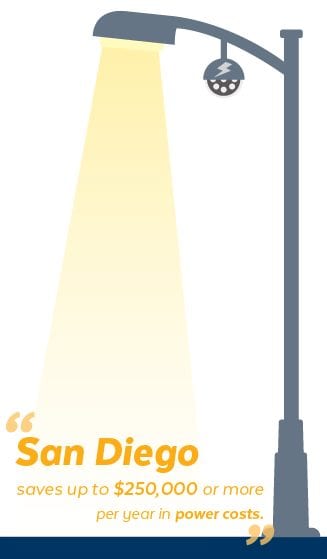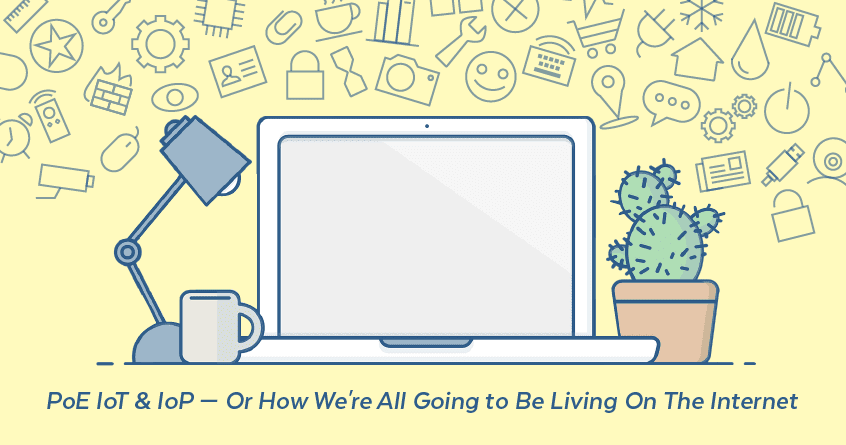The internet connected everyone and now we’re connecting everything to the internet. Our ability to power low-voltage smart devices wirelessly is enabling Big Data to get even bigger — from smart homes to smart buildings to smart cities — But the big question is: What’s next? Does the target get bigger or is the next target ourselves?
Smart Cities: How PoE and IoT Intersect to Form IoP
Our future cities will be super-smart, powered by the Internet of Things (IoT), Internet of Places (IoP), Power over Ethernet (PoE), and big data analytics. They’ll have interconnected systems and devices that interact and communicate with each other, autonomously. Planners will be able to collect and analyze the massive tons of data generated by intelligent urban platforms. They’ll use big data analytics to create solutions that enhance the quality of life in their cities.
San Diego, California, is a perfect example. The city deployed an IoP platform with IoT and PoE-driven components several years ago. It is using Ethernet cabling to deliver power to thousands of interconnected LED streetlights. Such lighting systems have low power and voltage requirements, making them cheaper to use. The PoE streetlights are integrated with the city’s IoT network, which makes it possible to monitor and control them remotely. The smart lamps are fitted with motion sensors to conserve energy by optimizing lighting based on the needs of each space. As a result, San Diego saves up to $250,000 or more per year in power costs.
Moreover, the city has intelligent street lights capable of monitoring traffic or listening for criminal activity. Some of these smart lamps have built-in PoE-powered video cameras, microphones, and microprocessors that are part of the city’s IoT. Since San Diego uses Ethernet as the primary medium for IoT connectivity, each connected device has a unique IP address. The smart infrastructure is, therefore, easier to maintain, manage, and configure.
With San Diego’s smart city system comes big data analytics to help with urban planning. Each of the platform’s IoT sensors sends raw data to a cloud-based repository in real time. So the city can analyze huge chunks of data from PoE cameras, microphones, and motion sensors. By using machine learning algorithms to analyze big data, planners can extract descriptive and predictive insights into pedestrian counts, traffic density, temperature, and other information specific to each monitored location or area. Such intelligence is useful in many ways, including mobility planning, city/real estate development planning, and pedestrian safety improvement.
When BIM Meets the IoT, Data-Driven Architecture Happens
With building information modeling (BIM), architects can efficiently assemble all components of building design into a complete system. The professionals are now leveraging the IoT to simplify data gathering and analytics for architectural design. We’re starting to see smart buildings with interconnected PoE devices like thermostats, cameras, and lights that respond to movement. By integrating such IoT devices into BIM software, architects can collect and analyze building information before developing their technical drawings.
A typical analytics-driven building design process begins with the deployment of interconnected sensors and apps. Such a system can track and record things like the movement of people in a building, usage of interior spaces, energy consumption, and the amount of natural light entering the building.
The design team may then use BIM software to analyze the data collected via PoE sensors to create best-fitting models for building owners or users. They could apply the insights to the simulation of a structure before it’s built. It’s also possible to simulate multiple sustainability techniques and features for optimal building performance. WeWork takes a similar approach by integrating analytics with architectural modeling to create workspaces for the tech industry.
The real estate company is collecting and analyzing tons of architectural data, including geospatial information, across the globe. Its real estate analysts are using the intelligence to identify projects worth taking up based on proximity to things like shopping malls or transportation hubs. They’re also using tools like app surveys and PoE room sensors to gather usage data from the properties they’re managing. By analyzing the data, the company’s designers can see what building specifications are already working (for instance, room configurations or desk arrangements). This analysis may then inform the design of similar types of spaces or properties.
PoE Lighting and Controls for the Advancement of Personal Wellbeing
According to research, the amount of lighting we’re exposed to (and the timing of the exposure) can impact our psychological functions. At home, for example, high-quality lighting can improve sleep and mood. However, each person may have unique lighting requirements for optimal health and comfort. The good news is that IoT, along with PoE lights, can be used to regulate lighting in a room based on the specific needs of each occupant.
In a project called the Swedish Healthy Home, researchers employed IoT to regulate home lighting and promote personal well being. They created a network that included PoE lighting to illuminate specific rooms based on user requirements. Each household member wore a special digital monitor that tracked their exposure to light throughout the day. It also monitored how light interacted with each person’s biological system. The tracker sent the data to a mobile IoT device, such as a smartphone, for storage.
Each time a household member got back home, the portable IoT device automatically transmitted the data to the home’s PoE lighting system. Smart lighting controls relied on the data to autonomously deliver a personalized lighting treatment for each individual.
Are People the Next Target for IoT Connectivity?
The number of interconnected objects and devices keeps rising, from streetlights in smart cities to motion sensors and PoE LEDs in intelligent building systems. But we’re also witnessing a gradual rise in the use of smart wearables that are connected to centralized databases. For example, IoT-based personal heart rate monitors enable doctors to track their patients’ health remotely. Such “intelligent” devices are the future of healthcare and other industries. That begs the question, is IoT slowly moving toward us? Maybe the next big thing in the sphere of smart technology is people becoming critical IoT components, just like smartphones and intelligent sensors? When everyone’s part of these IoP, IoT, and PoE-powered systems, we’re all going to be living on the internet, literally!

